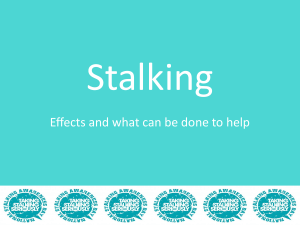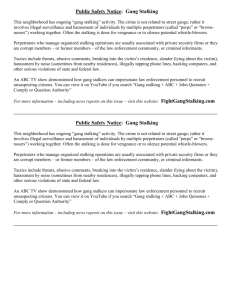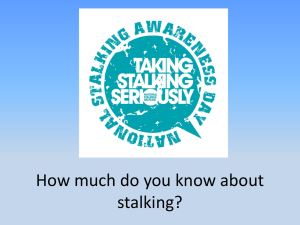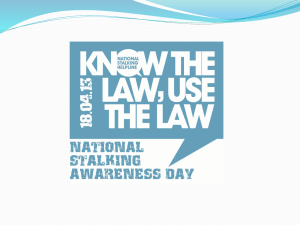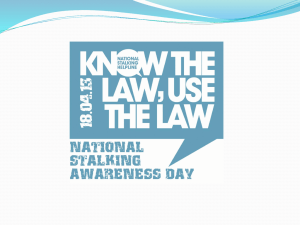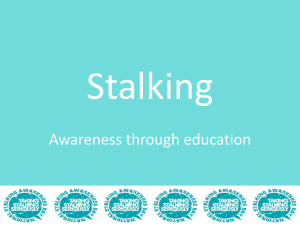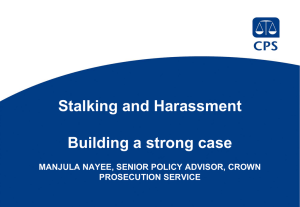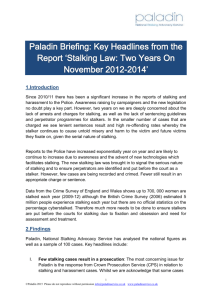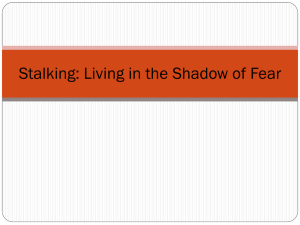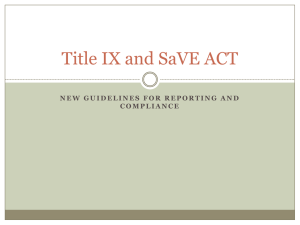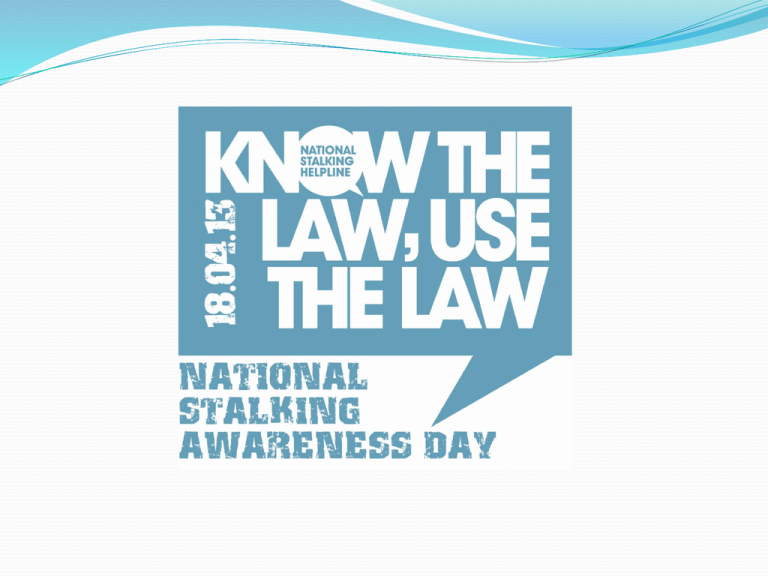
What is stalking?
Obsessive fixated pursuit
Mullen (1999) describes stalking as ‘ a constellation of behaviour’s in which an individual
inflicts upon another repeated unwanted intrusions and communications’. Intrusions
include making approaches, maintaining surveillance and gathering information.
What Effect does stalking have on a victim?
Research by the University of Leicester and Lorraine Sheridan found that serious
financial and social losses were reported by many victims of stalking. Half changed their
telephone numbers, half gave up social activities, half saw their performance at work
affected, a third relocated. Others gave up friends and family, or changed identity.
Hyper-vigilance
Potential escalation to physical and sexual violence
Stalking: The facts
1 in 5 women and 1 in 10 men will be stalked at some point in their lives
40% of victims are stalked by an ex partner, in many cases the partner would have
been emotionally or physically abusive during the relationship.
Ex partner stalking cases carry the highest risk of escalation in to physical violence.
On average a stalker will contact 21 people connected to the victim. This may
include family, friends, employer, neighbours, even the victim’s regular gym or
favourite café.
It is becoming more common for stalkers to use technology like GPS on mobiles,
tracker devices or spyware on phones to locate a victim
On 25th November stalking became a named offence in England and Wales for the
first time.
Stalking Typology
Mullen and Pathé
Rejected Stalker - Rejected stalking arises in the context of the breakdown of a close
relationship. Victims are usually former sexual intimates.
Resentful Stalker - Resentful stalking arises when the stalker feels as though they have
been mistreated or that they are the victim of some form of injustice or humiliation.
Intimacy Seeker - Intimacy Seeking stalking arises out of a context of loneliness and a
lack of a close confidante. Frequently Intimacy Seeking stalkers’ behaviour is fuelled by a
severe mental illness involving delusional beliefs about the victim
Incompetent Suitor - The Incompetent Suitor stalks in the context of loneliness or lust
and targets strangers or acquaintances. Sometimes this insensitivity is associated with
cognitive limitations or poor social skills consequent to autism spectrum disorders or
intellectual disability.
Predatory Stalker - Predatory stalking arises in the context of deviant sexual practices
and interests. Perpetrators are usually male and victims are usually female strangers in
whom the stalker develops a sexual interest.
For more detailed information about these typologies and for training workshops visit the
Stalking Risk Profile website at https://www.stalkingriskprofile.com/
Stalking and Health Professionals
Health care providers especially psychiatrists, psychologists, social workers
and general practitioners are particularly vulnerable to stalking.
The patients and clients who harass them are most often categorized as
intimacy seekers, incompetent suitors or resentful stalkers, through the
termination of a therapeutic relationship may give rise to a rejected
stalking pattern*
Stalking is likely to be under reported by health professionals who may be
inhibited by fear of being blamed or disbelieved. Violence is uncommon,
there preferred methods being phone, letters and gifts, these victims
nonetheless report distress, disruption and disillusionment with their
chosen profession.
It is not uncommon for a stalking victim to be pursued at work by the
perpetrator who may make malicious allegations against them, persistently
call, wait outside of work or follow the victim.
*information taken from Surviving Stalking by Michele Pathé
What is the law regarding
stalking?
The Protection from Harassment Act 1997 was amended under the Protection of
Freedoms Act 2012 to include offences of stalking for the first time on 25th
November 2012. There are now offences of both harassment and stalking in British
law. Stalking is illegal and no one should have to endure it.
The law in England and Wales provides a non exhaustive list of behaviours be
viewed as stalking and this includes following a person, publishing any statement or
other material relating or purporting to relate to a person, monitoring the use of a
person by internet, loitering in any place (whether public or private), contacting or
attempting to contact a person by any means.
The perpetrator does not need to be threatening violence before stalking becomes a
criminal offence. Under section 4A of the new stalking law, behaviour that causes
serious distress is viewed equally as behaviour that involves a fear of violence.
There are also civil remedies available such as seeking an injunctions under the
Protection from Harassment Act 1997 or a Non Molestation Order under the Family
Law Act 1996.
Stalking Risk Checklist
1. Are you very frightened?
2. Is there any previous domestic abuse and/or harassment history?
3. Has (…..)ever destroyed or vandalised any of your property?
4. Does (…..) turn up at your workplace, home, etc. unannounced or uninvited more than 3
times a week?
5. Does (…..) follow you or loiter around your workplace or home?
6. Has (…..) made any threats of physical or sexual violence?
7. Has (…..) harassed any third parties since the harassment began?
8. Has (…..) acted violently towards anyone else within the stalking incident?
9. Has (…..) persuaded other people to help him/her (wittingly or unwittingly)?
10. Is (…..) known to be abusing drugs or alcohol?
11. Is (…..) known to have been violent in the past?
This checklist should be used as an aide memoir rather than as a formal risk assessment.
For more information about the checklist visit
http://www.dashriskchecklist.co.uk/index.php?page=s-dash-for-use-in-stalking-casesby-practitioners
Anyone affected by stalking can call the National Stalking Helpline on
0808 802 0300 or email advice@stalkinghelpline.org
If you want any information about stalking or further statistics then
please email info@stalkinghelpline.org

